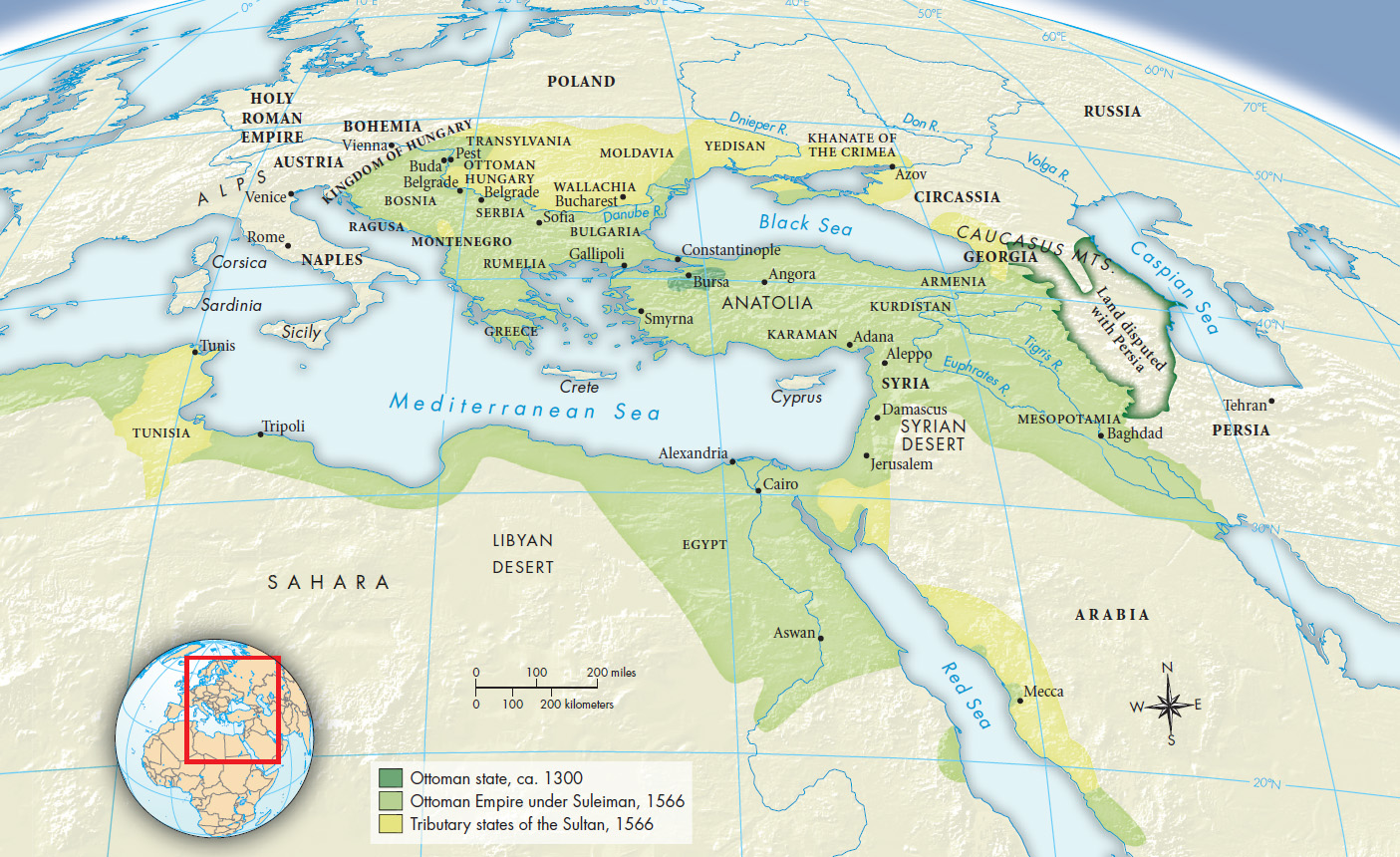A History of Western Society: Printed Page 487
A History of Western Society, Value Edition: Printed Page 500
The Growth of the Ottoman Empire
Most Christian Europeans perceived the Ottomans as the antithesis of their own values and traditions and viewed the empire as driven by an insatiable lust for warfare and conquest. In their view the fall of Constantinople was considered a historic catastrophe and the taking of the Balkans a form of despotic imprisonment. To Ottoman eyes, the world looked very different. The siege of Constantinople liberated a glorious city from its long decline under the Byzantines. Rather than being a despoiled captive, the Balkans became a haven for refugees fleeing the growing intolerance of Western Christian powers. The Ottoman Empire provided Jews, Muslims, and even some Christians safety from the Inquisition and religious war.
The Ottomans came out of Central Asia as conquering warriors, settled in Anatolia (present-day Turkey), and, at their peak in the mid-sixteenth century, ruled one of the most powerful empires in the world (see “The Ottoman and Persian Empires” in Chapter 14). Their possessions stretched from western Persia across North Africa and into the heart of central Europe (Map 15.4).

The Ottoman Empire was built on a unique model of state and society. Agricultural land was the personal hereditary property of the sultan, and peasants paid taxes to use the land. There was therefore an almost complete absence of private landed property and no hereditary nobility.
The Ottomans also employed a distinctive form of government administration. The top ranks of the bureaucracy were staffed by the sultan’s slave corps. Because Muslim law prohibited enslaving other Muslims, the sultan’s agents purchased slaves along the borders of the empire. Within the realm, the sultan levied a “tax” of one thousand to three thousand male children on the conquered Christian populations in the Balkans every year. These young slaves were raised in Turkey as Muslims and were trained to fight and to administer. Unlike enslaved Africans in European colonies, who faced a dire fate, the most talented Ottoman slaves rose to the top of the bureaucracy, where they might acquire wealth and power. The less fortunate formed the core of the sultan’s army, the janissary corps. These highly organized and efficient troops gave the Ottomans a formidable advantage in war with western Europeans. By 1683 service in the janissary corps had become so prestigious that the sultan ceased recruitment by force, and it became a volunteer army open to Christians and Muslims.
The Ottomans divided their subjects into religious communities, and each millet, or “nation,” enjoyed autonomous self-government under its religious leaders. The Ottoman Empire recognized Orthodox Christians, Jews, Armenian Christians, and Muslims as distinct millets, but despite its tolerance, the empire was an explicitly Islamic state. The millet system created a powerful bond between the Ottoman ruling class and religious leaders, who supported the sultan’s rule in return for extensive authority over their own communities. Each millet collected taxes for the state, regulated group behavior, and maintained law courts, schools, houses of worship, and hospitals for its people.
Istanbul (known outside the empire by its original name, Constantinople) was the capital of the empire. The “old palace” was for the sultan’s female family members, who lived in isolation under the care of eunuchs, men who were castrated to prevent sexual relations with women. The newer Topkapi palace was where officials worked and young slaves trained for future administrative or military careers. Sultans married women of the highest social standing, while keeping many concubines of low rank. To prevent the elite families into which they married from acquiring influence over the government, sultans procreated only with their concubines and not with official wives. They also adopted a policy of allowing each concubine to produce only one male heir. At a young age, each son went to govern a province of the empire accompanied by his mother. These practices were intended to stabilize power and prevent a recurrence of the civil wars of the late fourteenth and early fifteenth centuries.
Sultan Suleiman undid these policies when he boldly married his concubine, a former slave of Polish origin named Hürrem, and had several children with her. (See “Individuals in Society: Hürrem.”) Starting with Suleiman, imperial wives began to take on more power. Marriages were arranged between sultans’ daughters and high-ranking servants, creating powerful new members of the imperial household. Over time, the sultan’s exclusive authority waned in favor of a more bureaucratic administration.